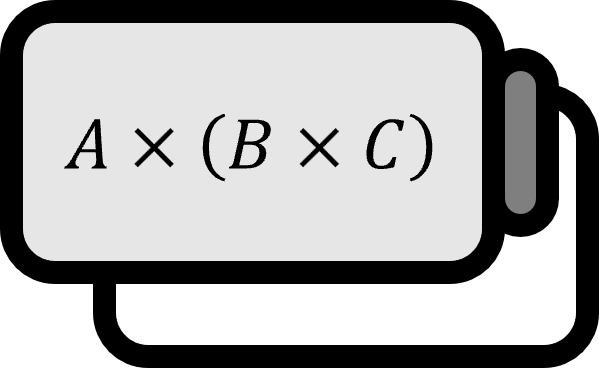Kronecker Delta through Matrices
Definition
We define $\delta_{ij}$, as shown below, to be the Kronecker delta.
$$ \delta_{ij} = \begin{cases} 1 & \text{if } i = j \\ 0 & \text{if } i \ne j \end{cases} $$
Explanation
The Kronecker delta is typically encountered around the second year of undergraduate studies in science and engineering when vector calculus becomes prominent. While it is a useful tool for converting complex vector calculations into simpler scalar calculations, it can be challenging to grasp its meaning when first introduced. It may not seem like a function at first glance, and understanding why it is $1$ if the subscripts are the same, or $0$ if they are different, can be elusive. Let’s explore the Kronecker delta in a way not often explained in textbooks.
Observe that the Kronecker delta has two subscripts, reminiscent of another object with two subscripts: matrices. Specifically, the Kronecker delta $\delta_{ij}$ is the element in the $i$th row and $j$th column of an identity matrix (unit matrix) $I$.
Re-definition
We use $\delta_{ij}$ to denote the element of the $i$th row and $j$th column of the identity matrix $I$, which we call the Kronecker delta.
$$ I = \begin{pmatrix} 1 & 0 & 0 \\ 0 & 1 & 0 \\ 0 & 0 & 1 \end{pmatrix} = \begin{pmatrix} \delta_{11} & \delta_{12} & \delta_{13} \\ \delta_{21} & \delta_{22} & \delta_{23} \\ \delta_{31} & \delta_{32} & \delta_{33} \end{pmatrix} $$
$$ I_{ij} = [I]_{ij} = \delta_{ij} = \begin{cases} 1 & \text{if } i = j \\ 0 & \text{if } i \ne j \end{cases} $$
Formulas
Let $\mathbf{a} = \begin{bmatrix} a_{1} & a_{2} & a_{3} \end{bmatrix}^{\mathsf{T}}$ and $\mathbf{b} = \begin{bmatrix} b_{1} & b_{2} & b_{3} \end{bmatrix}^{\mathsf{T}}$.
The dot product of two vectors can be expressed using the Kronecker delta in the form of the following bilinear form. $$ \begin{align*} \mathbf{a} \cdot \mathbf{b} = \mathbf{a}^{\mathsf{T}} I \mathbf{b} &= \begin{bmatrix} a_{1} & a_{2} & a_{3} \end{bmatrix} \begin{bmatrix} \delta_{11} & \delta_{12} & \delta_{13} \\ \delta_{21} & \delta_{22} & \delta_{23} \\ \delta_{31} & \delta_{32} & \delta_{33} \end{bmatrix} \begin{bmatrix} b_{1} \\ b_{2} \\ b_{3} \end{bmatrix} \\ &= \begin{bmatrix} a_{1}\delta_{11} & a_{2}\delta_{22} & a_{3}\delta_{33} \end{bmatrix} \begin{bmatrix} b_{1} \\ b_{2} \\ b_{3} \end{bmatrix} \\ &= a_{1}\delta_{11}b_{1} + a_{2}\delta_{22}b_{2} + a_{3}\delta_{33}b_{3} \\ &= \sum\limits_{i=1}^{3} \delta_{ii}a_{i}b_{i} = \delta_{ii}a_{i}b_{i} \\ \end{align*} $$
The final equality uses the Einstein notation.
Using the Einstein notation, the following formula is derived. $$ \begin{align*} \delta_{ii} &= 3 \tag{2.1} \\ \delta_{ij}\delta_{jk} &= \delta_{ik} \tag{2.2} \\ \delta_{ii}\delta_{jj} &= 9 \tag{2.3} \\ \delta_{ii}\delta_{jj} &= 6 (i \ne j)\tag{2.4} \end{align*} $$
2.1. $\delta_{ii} = \sum\delta_{ii}$ is the sum of all diagonal components of the identity matrix, also known as the trace.
$$ \delta_{ii} = \Tr (I) = 1 + 1 + 1 = 3 $$
2.2. The matrix product $AB$ of two matrices $A =[a_{ij}]$ and $B = [b_{ij}]$ yields the following component in the $i$th row and $k$th column.
$$ [AB]_{ik} = \sum\limits_{j} a_{ij}b_{jk} = a_{ij}b_{jk} $$
Therefore, $\delta_{ij}\delta_{jk}$ is equivalent to the element in the $i$th row and $k$th column of the product of two identity matrices. Since the product of two identity matrices is an identity matrix, this is the same as the element in the $i$th row and $k$th column of the identity matrix, i.e., $\delta_{ik}$.
2.3. Since it is the product of the traces of two identity matrices, $$ \delta_{ii}\delta_{jj} = \left( \sum_{i}\delta_{ii} \right) \left( \sum_{j}\delta_{jj} \right) = \Tr(I) \Tr(I) = 3 \times 3 = 9 $$
